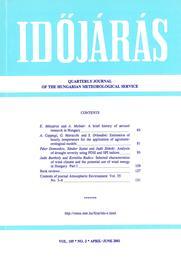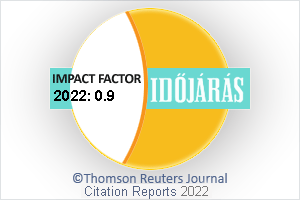Időjárás - Quarterly Journal of the Hungarian Meteorological Service (OMSZ)
Vol. 105, No. 2 * Pages 63–134 * April - June 2001
 |
|
 download [pdf: 31427 KB]
download [pdf: 31427 KB]
A brief history of aerosol research in Hungary
Mészáros Ernõ; Molnár Ágnes
idojaras.2001.2.1 (p. 63–)
Mészáros Ernõ; Molnár Ágnes
idojaras.2001.2.1 (p. 63–)
Estimation of hourly temperature for the application of agrometeorological models
Cappugi, A., Maracchi, G., Orlandini, S.
idojaras.2001.2.2 (p. 81–)
Cappugi, A., Maracchi, G., Orlandini, S.
idojaras.2001.2.2 (p. 81–)
Analysis of drought severity using PDSI and SPI indices
Domonkos Péter, Szalai Sándor, Zoboki Judit
idojaras.2001.2.3 (p. 93–)
Domonkos Péter, Szalai Sándor, Zoboki Judit
idojaras.2001.2.3 (p. 93–)
Selected characteristics of wind climate and the potential use of wind energy in Hungary. Part I
Judit Bartholy; Kornélia Radics
idojaras.2001.2.4 (p. 109–)
Judit Bartholy; Kornélia Radics
idojaras.2001.2.4 (p. 109–)
IDŐJÁRÁS - Quarterly Journal

Az IDŐJÁRÁS a HungaroMet Nonprofit Zrt. negyedévenként megjelenő angol nyelvű folyóirata
Megrendelhető a journal.idojaras@met.hu címen.
A szerzőknek szánt útmutató itt olvasható.
Megrendelhető a journal.idojaras@met.hu címen.
A szerzőknek szánt útmutató itt olvasható.









